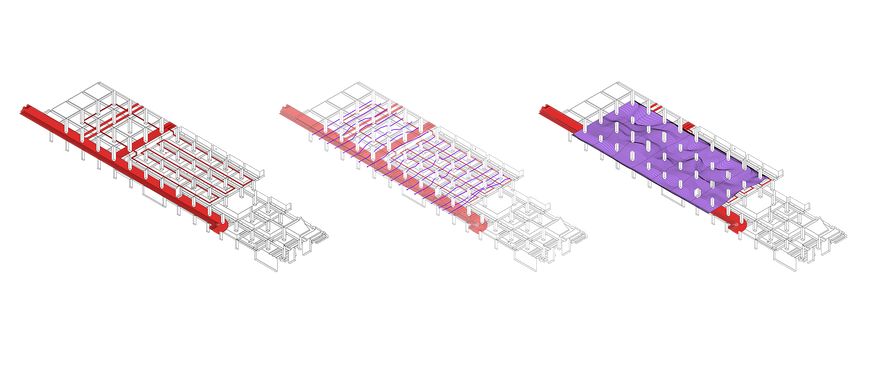
.png)
NOTASH DADJOO
ARCHITECTURAL STUDIO
IRANMALL ART GALLERY

Clients: Ayandeh Bank, AlborzTat Co., Paydar Pei Sazeh Co.
Contractor: Gostaresh Sanat Iran Co.
Architect: Notash Dadjoo
Project Manager: Mehdi Asadian
Design Team: Notash Dadjoo (Architect), Shahab Saffari (Graphic Designer), Morteza Makani (Animator)
Other team members: Reza Dehghani (PhD in Civil Engineering), Mohammad Gerami (Architect), Hamidreza Alimohammadi (Mechanical Engineer), Reza Shekarlou (Mechanical Engineer), Ahmad Ghaffari (Electrical Engineer), Maryam Shakeri (BArch student).
Area: 6100 square meters
Total Projec area (Iranmall):1800000 square meters
Place: Tehran province, Tehran, Iran.
Designed year: 2017
Awards: 3rd Place In week 37 of INSPIRELI AWARD 2017

Bazar-e-Bozorg-e-Iran (Iran Mall) is a mega complex with an approximate area of 1.8 million square meters which contains numerous spatial functions such as commercial, cultural, sport, religious, hotel, offices and many more. One of the function in the area of cultural spaces is the art gallery. This space, which has previously been part of the parking lot, has been transformed into a 6100 square meters art gallery. 4200 square meters of this space has been allocated to exhibition areas which hadn’t had any specific architectural plan or interior design. At this time Notash Dadjoo Studio in collaboration with Gostaresh Sanat Iran Co., which is one of the major contractors in construction of Iran Mall complex, gives an interior design proposal to their client.
Near 250 active art galleries are existed in Tehran which mostly situated in central or northeastern part of the city. Therefor those parts are known as art zones of the city. Among all these galleries only 50 of them succeed to have financial profits of their professional activities. Iran Mall Art Gallery faces serious challenges in audience attraction due to its location, at the far West of Tehran, and conditions. Being Far away from city art zone, large area, being in a complex with commercial majority functions, revenue challenges due to the conditions of the art market in Tehran are some its challenges. Based on all project constraints and in order to attract audiences, changing the usual definition of gallery space and creating a different spatial quality was considered in the design approach of this space. In this way, by rearranging spatial layouts and using dynamic forms in design process, we tried to transform the usual spatial characteristics of art galleries of Tehran, which generally have white cubic and minimal spaces, in terms of both architectural forms and spatial sense of the place. In adoption of this approach, its large exhibition area became the design vantage point compared to common small and limited gallery spaces in order to hold national and international art events. Having high height is one it’s spatial advantages which is matched to wide dimensions of the space, but since this space was designed for parking lot in first place and experienced the functional changes during construction progress, there were many constraints ahead of design. The massive amount of mechanical elements for feeding adjacent areas and the shape of ceiling structure which designed to bear the roof garden loads are two major constraints imposed on this space.
The main idea behind the design is to integrate all the spatial elements of the space such as the ceiling, the column, the partitions, and the floor. In this way line was chosen as a connector factor of all these elements. By going through space and overlapping with spatial sections, these lines shaping it. In floor it turned to flooring texture with raw iron and continues to form the partitions by iron sheets. The edge lines of columns brought out from linear floor texture and shaping the ceiling by continuing smoothly through it. All lines started from the transparent wall of terrace (smoking room) which is a natural light source and in same time act as a spatial filter too. It transforming the sunlight rays to spatial rays and finally spatial lines by allowing sunlight to pass through itself. The lines which comes from the light and create the space out of sunlight.
Almost all art galleries in Tehran owned a collection of art works which had been exhibited before and they feature it is small and limited areas. Also one of the hallmarks of museums is to possess and permanently exhibit some art works. For this reason, Iran mall art gallery divided into two major areas, temporary exhibition area and permanent exhibition area. The bigger area dedicated to temporary exhibition area because providing enough space to hold various art events is important. For doing so and creating proper circulation and directing the visitor to the permanent exhibition area, the temporary exhibition area is divided into three sections which separated from each other through partitions. To support all kind of art especially modern art such as audio art, performances, video art and interdisciplinary arts a particular area was considered. The use of dynamic and fluid forms on the roof in combination with the partition's forms is direct visitor through permanent exhibition area. Eventually, planning the Art Gallery is completed by considering areas such as public toilets, art work store room and books and crafts shop while coffee shop, office room, facility rooms and workshop was pre-planned for it.











